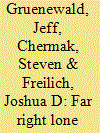|
|
|
Sort Order |
|
|
|
Items / Page
|
|
|
|
|
|
|
| Srl | Item |
| 1 |
ID:
124537


|
|
|
|
|
| Publication |
2013.
|
| Summary/Abstract |
Little is known about the nature of far-right lone wolf terrorism and how this form of violence varies across different types of suspects. Relying on data from the Extremist Crime Database (ECDB), we comparatively examine characteristics of far-right homicides in the United States perpetrated by suspects with no evident affiliations with domestic terrorist organizations. Surprisingly, we found that this form of lone wolf terrorism has generally not increased during the past decade. We also found important differences, such as in suspects' mental health, in statuses of homicide offenders who operate alone compared to those who associate or act with others.
|
|
|
|
|
|
|
|
|
|
|
|
|
|
|
|
| 2 |
ID:
140780


|
|
|
|
|
| Summary/Abstract |
The domestic far-right movement has existed in the United States for many years. During that time, groups have appeared, disappeared, and reappeared. Unfortunately, very little is known about what causes these groups to disband. An interdisciplinary approach identified external and internal correlates of organizational death to empirically test which of these correlates influences whether a group dies. Results from this study provided empirical support for some previously only anecdotal explanations for organizational death, while also undermining other claims.
|
|
|
|
|
|
|
|
|
|
|
|
|
|
|
|
| 3 |
ID:
138778


|
|
|
|
|
| Summary/Abstract |
Despite several overlaps between crime and terrorism, criminological examinations of terrorism to date have been limited. To fill this gap in the research, we examine several individual and contextual socio-demographic characteristics of a diverse sample of extremists operating in the United States who have committed violent crimes. In addition, we provide a comparative analysis to explain and understand differences between extremists who have committed violent crimes while active in either far-Right, far-Left (including environmental and animal rights extremists), or Al Qaeda and affiliated movements. To assess the impact of external factors on the nature of domestic extremist violence, we also comparatively examine these three types of domestic extremists before and after the September 11, 2001 terrorist attacks. We find several similarities across domestic extremists but many important suspect- and county-level differences as well. We end the paper with suggestions for future research that could extend the criminological study of terrorism.
|
|
|
|
|
|
|
|
|
|
|
|
|
|
|
|
| 4 |
ID:
120436


|
|
|
|
|
| Publication |
2013.
|
| Summary/Abstract |
Few studies have explored the factors that distinguish violent from nonviolent far-right hate groups. We examine four categories of factors on hate groups: (1) Organizational capacity, (2) Organizational constituency, (3) Strategic connectivity, and (4) Structural arrangements. Age and size, groups in conflict, groups led by charismatic leaders, groups that advocated for leaderless resistance tactics, and region increased a group's propensity to commit violence. Groups that published ideological literature were significantly less likely to be violent. By identifying factors that distinguish violent from nonviolent groups, this study helps us better understand characteristics of violent far-right hate groups in the United States.
|
|
|
|
|
|
|
|
|
|
|
|
|
|
|
|
|
|
|
|
|